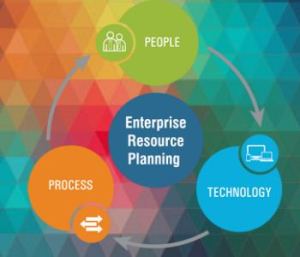ERP Implementation Strategy requires three things to take into consideration
An organization without an ERP or Enterprise Resource Planning system would be running on so many software that do not allow interaction. Furthermore, customization could be difficult in some instances. This naturally could negatively affect the optimized functioning of the business activities.
 These changed however with the implementation of the ERP software. Information constantly flows and enables one to follow client processes anytime, regardless which part of the process they are going through. Expenses and purchases are registered in a central database which allows for having close control over these tasks. Determining the best ERP implementation strategy could be tricky. It may sound simple enough, such as defining one what needs, designing, configuring, running some testing, training employees, etc. However, as anyone who has been involved with its implementation before could attest that this is not typically the scenario.
These changed however with the implementation of the ERP software. Information constantly flows and enables one to follow client processes anytime, regardless which part of the process they are going through. Expenses and purchases are registered in a central database which allows for having close control over these tasks. Determining the best ERP implementation strategy could be tricky. It may sound simple enough, such as defining one what needs, designing, configuring, running some testing, training employees, etc. However, as anyone who has been involved with its implementation before could attest that this is not typically the scenario.
To avoid the same mistakes when defining the best implementation strategy, below are the three main things to consider.
1. Waterfall against agile software development. Typically, most consultants as well as system integrators follow the waterfall approach that entails a more formalized and sequential approach to design, build and test. On the other hand, agile requires a more iterative and less structured method for rolling out new functions. Waterfall typically works for bigger organizations and those wanting to standardize their process. Agile could work for smaller ones or more nimble companies that are not looking for a more standardized operations. It is important to understand the advantages and disadvantages, the tradeoffs and risks of every approach and decided where the implementation would fall.
2. Reengineering business processes or paving the cowpaths. Rushing into the system implementations without a deliberate focus on process reengineering could likely automate already inefficient processes or what is called the paving the cowpaths. Project managers and CIOs who are more keen on transforming and enhancing their business strategies must build the right level of effort and focus in the plans for the project, otherwise their organizations would revert naturally to the cowpaths regardless of how hard they may try. Inexperienced consultants and system integrators tend to underestimate the time and effort needed to focus on business methods that would complicate the problem further.
3. Standardization against autonomy. During the project planning stage, it’s necessary to find out if and where the company would standardize processes across the firm. Most clients embark on implementations that tend to heavily standardize across the organization. Wherever the firm may fall on the spectrum, it is vital to recognize that standardization would need more time up front in the reengineering and the requirements phase of the project. On the other hand, companies leaning towards less standardization would require more resources and time during the designing, testing and training phases.
There are other strategic considerations that should be defined as well before signing contracts and starting the application, like organizational change management and communications, data, integration, language, single system against best of breed and many others. The three considerations above are a good place to begin and must be defined further together with others as part of an effective strategy.
Ten Easy Steps that One Should Keep In Mind for a Successful Outcome In The IT Outsourcing
The following items are the ten steps to outsourcing success that companies and business organizations should keep in mind.
1. Defining clear objectives is the key to successful outsourcing strategy. The objectives state the reasons for the endeavor. Moreover, it illuminates business value and offer a working framework to make decisions regarding which vendor to choose, what outsourcing model to use, the projects to be outsourced and the risk levels to assume.
2.Counting the costs is very important. With so much pressure these days to cut on expenses by putting expensive skilled labor tasks offshore; it is easy to underestimate the true costs that are involved. There may be hidden costs that could add to the actual work.
the costs is very important. With so much pressure these days to cut on expenses by putting expensive skilled labor tasks offshore; it is easy to underestimate the true costs that are involved. There may be hidden costs that could add to the actual work.
3. Understanding and managing risks actively by keeping a list of possible risks and awareness that there may be things that could go wrong along the way. Moreover, it is important to prioritize and manage the risks aggressively based on the impact expected.
4. Measure and track the benefits in an objective manner by letting the numbers speak for themselves. If the benefits are short of what one expects, these should be known to take corrective actions or measures. On the other hand, if performance is extraordinary, this should not be downplayed either.
5. It is important to use an effective outsourcing model that has been proven to be successful. Moreover, the model should meet an organization’s business model and fits with current standards. There are many outsourcing models, each with weaknesses, strengths and the right applications.
6. Choosing complementary business partners is more important than choosing the right business model. When evaluating offshore service providers, there should be a request for proposal and information process. All prospective vendors should be assessed if they are equipped to meet functional and technical requirements.
7. An organization or even an individual should start slowly and build gradually. It is important to take time and make certain to establish a robust foundation for executions in the future. Start small with one, well-defined self-contained pilot project.
8. Another important step is to monitor and evaluate progress to understand the relative success or failure of the overall outsourcing strategy. To do this, one should start with an established baseline of the latest performance with the use of the same scorecard metrics that are used to evaluate offshore performance.
9. Look for specific experience fit to avoid being someone’s ‘guinea pig’. This is especially important when outsourcing complicated technical projects like the development of software. For instance, if one needs a business plan to open a retail store, the best results could be achieved if the consultant hired has verifiable experience in the retail field.
10. Maintaining a degree of separation between offshore and onshore resource teams may be reasonable, but could result to suboptimal performance.
Thus, it is also important to keep the relationship personal. This is because ultimately, what would make any outsourcing engagement successful or otherwise are the people.
